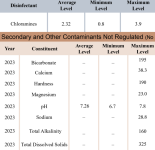You can just test your local water source at the mainline going into the home. There’s usually a spigot or, if you have an outdoor spigot nearby the main, let that run for a few minutes and then test the water. That will tell you what the incoming FC/CC is.
The reason why I asked and why it is important is because water softener resins are specified according to how much cross-linking they have. The higher the cross linking, the more resistant resins are to oxidation damage. If your incoming water has high total chlorine then you should really neutralize the chlorine prior to softening to avoid damage to the resin. As the resin ages and gets oxidized, its softening capacity decreases. Also, if your municipal supply has iron in it, that can be troublesome too as iron will react with the resin and lock itself into the resin structure thereby reducing softening capacity. Iron contamination can not be removed by regeneration as it typically requires an acidic soak to displace the iron. People that do high quality softener installations will often prefilter the water using a granular activated charcoal (GAC) filter to remove chlorine and metals. GAC filters are one-and-done type filters that can’t be regenerated and so they need to be changed annually. Normally you’d want a sediment filter (municipal water is often very dirty), then a GAC filter, and then a mineral softener so that the system can be operated for a long time.
Up to you on how complex you want to make it. I’d look for an RV filter that can be taken apart so that if the ion exchange resin needs changing you can do that yourself without having to throw away a perfectly good resin tank. You can often by softener resins more cheaply by the 40lbs sack so that you can refill the resin bed as-needed.



